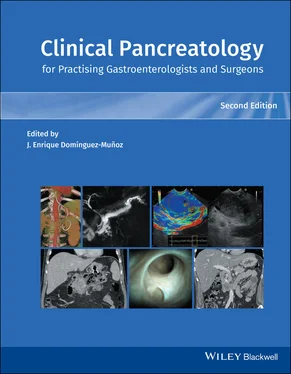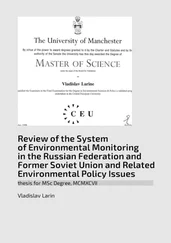54 54 Rösch T. Staging of pancreatic cancer. Analysis of literature results. Gastrointest Endosc Clin North Am 1995; 5:735–739.
55 55 Wang AY, Yachimski PS. Endoscopic management of pancreatobiliary neoplasms. Gastroenterology 2018; 154:1947–1963.
56 56 Cotton PB, Lehman G, Vennes J, et al. Endoscopic sphincterotomy complications and their management: an attempt at consensus. Gastrointest Endosc 1991; 37:383–393.
57 57 Masci E, Mariani A, Curioni S, et al. Risk factors for pancreatitis following endoscopic retrograde cholangiopancreatography: a meta‐analysis. Endoscopy 2003; 35:830–834.
58 58 Kochar B, Akshintala VS, Afghani E, et al. Incidence, severity, and mortality of post‐ERCP pancreatitis: a systematic review by using randomized, controlled trials. Gastrointest Endosc 2015; 81:143–149.e9.
59 59 Andriulli A, Loperfido S, Napolitano G, et al. Incidence rates of post‐ERCP complications: a systematic survey of prospective studies. Am J Gastroenterol 2007; 102:1781–1788.
60 60 Ito K, Fujita N, Noda Y, et al. Relationship between post‐ERCP pancreatitis and the change of serum amylase level after the procedure. World J Gastroenterol 2007; 13:3855–3860.
61 61 Avgerinos DV, Llaguna OH, Lo AY, et al. Management of endoscopic retrograde cholangiopancreatography: related duodenal perforations. Surg Endosc 2009; 23:833–838.
62 62 Morgan KA, Fontenot BB, Ruddy JM, et al. Endoscopic retrograde cholangiopancreatography gut perforations: when to wait! When to operate! Am Surg 2009; 75:477–483; discussion 483–484.
63 63 Dumonceau J‐M, Andriulli A, Elmunzer BJ, et al. Prophylaxis of post‐ERCP pancreatitis: European Society of Gastrointestinal Endoscopy (ESGE) Guideline, updated June 2014. Endoscopy 2014; 46:799–815.
64 64 Aktas H, Mensink PBF, Haringsma J, et al. Low incidence of hyperamylasemia after proximal double‐balloon enteroscopy: has the insertion technique improved? Endoscopy 2009; 41:670–673.
65 65 Aktas H, de Ridder L, Haringsma J, et al. Complications of single‐balloon enteroscopy: a prospective evaluation of 166 procedures. Endoscopy 2010; 42:365–368.
66 66 Delhaye M, Engelholm L, Cremer M. Pancreas divisum: congenital anatomic variant or anomaly? Contribution of endoscopic retrograde dorsal pancreatography. Gastroenterology 1985; 89:951–958.
67 67 Garg PK, Khajuria R, Kabra M, et al. Association of SPINK1 gene mutation and CFTR gene polymorphisms in patients with pancreas divisum presenting with idiopathic pancreatitis. J Clin Gastroenterol 2009; 43:848–852.
68 68 Nagpal SJS, Peeraphatdit T, Sannapaneni SK, et al. Clinical spectrum of adult patients with annular pancreas: findings from a large single institution cohort. Pancreatology 2019; 19:290–295.
69 69 Jagannath S, Garg PK. Recurrent acute pancreatitis: current concepts in the diagnosis and management. Curr Treat Options Gastroenterol 2018; 16:449–465.
3 Definition of Complications and Severity of Acute Pancreatitis for Clinical Practice
David X. Jin1,2, Peter A. Banks1,2, and Julia McNabb‐Baltar1,2
1Brigham and Women’s Hospital
2 Harvard Medical School, Boston, MA, USA
The clinical severity and complications of acute pancreatitis (AP) can be highly variable. While the majority of patients develop a mild course, 5–15% develop severe disease, with mortality approaching 50% in some cases [1–8]. This clinical variability led to a need for accepted definitions of severity and complications to aid study and guide management.
The Atlanta Classification 1992
The 1992 Atlanta Classification (AC) offered the first universally accepted set of definitions for AP ( Table 3.1) [9]. AP was defined as an acute inflammatory process of the pancreas that may also involve regional tissue or remote organ systems. Severe AP was broadly defined as the presence of (i) organ failure (shock, pulmonary insufficiency, renal failure, gastrointestinal bleeding) and/or (ii) local complications (especially pancreatic necrosis, but also abscess or pseudocyst). Early predictors of severity included three or more of Ranson’s criteria or an Acute Physiology, Age, and Chronic Health Evaluation (APACHE)‐II score of 8 or more. Additional terms, including mild AP, acute fluid collections, pancreatic necrosis, acute pseudocyst, and pancreatic abscess, were defined.
The AC served as the first clinically based classification system and provided the framework for how AP is defined today. However, some of the definitions proved ambiguous and were used inconsistently, for example (i) a uniform serum lipase and/or amylase threshold for diagnosis was not established; (ii) transient and persistent organ failure were not differentiated; and (iii) a heterogeneous group of patients with varying severity and mortality were combined into a single severe AP category [10]. These limitations led to large variability in the interpretation of organ failure and local complications [10,11].
With better understanding of the pathophysiology of organ failure and pancreatic necrosis, two widely adopted classification systems were subsequently derived: the Revised Atlanta Classification (RAC) and Determinant‐Based Classification (DBC) [12,13].
The Revised Atlanta Classification 2012
The RAC was derived through an iterative consultation process, ultimately generating consensus recommendations from the members of 11 international pancreatic societies [12]. The RAC provides a comprehensive classification of AP, including definitions of diagnosis, type (interstitial edematous versus necrotizing pancreatitis), clinical phase (early versus late), complications (local and systemic), and severity (mild, moderately severe, or severe). The scope of this chapter focuses on individual complications and definitions of severity.
Definition of Organ Failure and Complications in Acute Pancreatitis
Organ Failure
Persistent organ failure is the primary determinant of outcomes and accounts for nearly all the mortality in AP [14–16]. Established risk factors include older age, comorbid conditions, obesity, elevated triglyceride levels, and certain etiologies (alcohol) [17–20]. Organ failure according to RAC is defined as a score of 2 or above for at least one of three organ systems using the modified Marshall scoring system ( Table 3.2) [21]. Persistent organ failure is defined as organ failure which lasts more than 48 hours while transient organ failure lasts less than 48 hours.
Table 3.1 Comparison of Atlanta Classification, Revised Atlanta Classification, and Determinant‐Based Classification.
Source: adapted from Bradley [9].
| Atlanta Classification |
Mild |
No organ failure and no local complications |
| Severe |
Organ failure and/or local complications |
| Revised Atlanta Classification |
Mild |
No organ failure and no local or systemic complications |
| Moderately severe |
Transient organ failure and/or local and/or systemic complications |
| Severe |
Persistent organ failure |
| Determinant‐Based Classification |
Mild |
No organ failure and no necrosis |
| Moderate |
Transient organ failure and/or sterile necrosis |
| Severe |
Persistent organ failure or infected necrosis |
|
Critical |
Persistent organ failure and infected necrosis |
Local complications typically refer to a variety of pancreatic and peripancreatic fluid collections that differ in both composition and time to development. Other local complications include gastric outlet dysfunction, splanchnic vein thrombosis, and colonic necrosis. Local complications should be suspected when there is persistence or recurrence of pain, organ dysfunction, fever, or leukocytosis. High‐resolution contrast‐enhanced computed tomography (CECT) is often the diagnostic test of choice. In the RAC, local complications do not by themselves constitute severe AP.
Читать дальше












